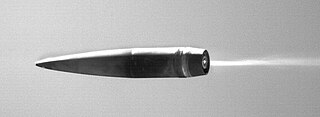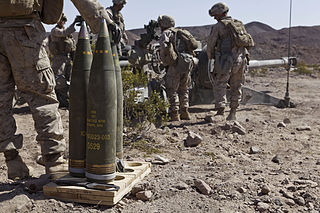Related Research Articles

Artillery are ranged weapons that launch munitions far beyond the range and power of infantry firearms. Early artillery development focused on the ability to breach defensive walls and fortifications during sieges, and led to heavy, fairly immobile siege engines. As technology improved, lighter, more mobile field artillery cannons developed for battlefield use. This development continues today; modern self-propelled artillery vehicles are highly mobile weapons of great versatility generally providing the largest share of an army's total firepower.

The M198 is a medium-sized, towed 155 mm artillery piece, developed for service with the United States Army and Marine Corps. It was commissioned to be a replacement for the World War II-era M114 155 mm howitzer. It was designed and prototyped at the Rock Island Arsenal in 1969 with firing tests beginning in 1970 and went into full production there in 1978. It entered service in 1979 and since then 1,600 units have been produced.

The 8 inch (203 mm) M110 self-propelled howitzer is an American self-propelled artillery system consisting of an M115 203 mm howitzer installed on a purpose-built chassis. Before its retirement from US service, it was the largest available self-propelled howitzer in the United States Army's inventory; it continues in service with the armed forces of other countries, to which it was exported. Missions include general support, counter-battery fire, and suppression of enemy air defense systems.

A shell, in a military context, is a projectile whose payload contains an explosive, incendiary, or other chemical filling. Originally it was called a bombshell, but "shell" has come to be unambiguous in a military context. A shell can hold a tracer.

Base bleed or base burn(BB) is a system used on some artillery shells to increase range, typically by about 20–35%. It expels gas into the low pressure area behind the shell to reduce base drag (it does not produce thrust; if it did it would be a rocket-assisted projectile). Since it extends the range by a percentage, it is more useful on longer range artillery where an increase of approximately 5–15 kilometres (3.1–9.3 mi) can be achieved, and it also was found that the reduced turbulence gave the projectiles a more consistent trajectory, resulting in tighter grouping and efficient shelling more than 40 km away.

The Singapore Self-Propelled Howitzer 1 Primus is a self-propelled howitzer armed with a 155 mm howitzer. Developed jointly by the Singapore Armed Forces (SAF), Defence Science and Technology Agency (DSTA) and Singapore Technologies Kinetics, it was officially inducted to the Singapore Artillery in 2004. Primus is derived from the Artillery motto In Oriente Primus.

The M119 howitzer is a lightweight 105 mm howitzer, used by the United States Army. It is the American licensed version of the British L119 light gun. The M119 is typically towed by the M1097 or M1152 High Mobility Multi-Purpose Wheeled Vehicle (HMMWV), and can be easily airlifted by helicopter, or airdropped by parachute.

A dual-purpose improved conventional munition (DPICM) is an artillery or surface-to-surface missile warhead designed to burst into submunitions at an optimum altitude and distance from the desired target for dense area coverage. The submunitions use both shaped charges for the anti-armor role, and fragmentation for the antipersonnel role, hence the nomenclature "dual-purpose". Some submunitions may be designed for delayed reaction or mobility denial (mines). The air-to-surface variety of this kind of munition is better known as a cluster bomb. They are banned by more than 100 countries under the Convention on Cluster Munitions.

The 152 mm gun-howitzer M1955, also known as the D-20, is a manually loaded, towed 152 mm gun-howitzer artillery piece, manufactured in the Soviet Union during the 1950s. It was first observed by the west in 1955, at which time it was designated the M1955. Its GRAU index is 52-P-546.

The PAW 600 was a lightweight anti-tank gun that used the high-low pressure system to fire hollow charge warheads. In 1945, it was used operationally by the Wehrmacht in small numbers. Only about 260 were produced before the war's end.

A rocket-assisted projectile (RAP) is a cannon, howitzer, mortar, or recoilless rifle round incorporating a rocket motor for independent propulsion. This gives the projectile greater speed and range than a non-assisted ballistic shell, which is propelled only by the gun's exploding charge. Some forms of rocket-assisted projectiles can be outfitted with a laser-guide for greater accuracy.

A precision-guided munition is a guided munition intended to precisely hit a specific target, to minimize collateral damage and increase lethality against intended targets. During the First Gulf War guided munitions accounted for only 9% of weapons fired, but accounted for 75% of all successful hits. Despite guided weapons generally being used on more difficult targets, they were still 35 times more likely to destroy their targets per weapon dropped.

155 mm is a NATO-standard artillery shell caliber that is used in many field guns, howitzers, and gun-howitzers. It is defined in AOP-29 part 1 with reference to STANAG 4425.

In artillery, caliber or calibre is the internal diameter of a gun barrel, or, by extension, a relative measure of the barrel length.
The high–low system is a design of cannon and anti-tank warfare launcher using a smaller high-pressure chamber to store propellant. It allows a much larger projectile to be launched without the heavy equipment usually needed for large caliber weapons. When the propellant is ignited, the higher pressure gases are bled out through vents at reduced pressure to a much larger low pressure chamber to push a projectile forward. The high-low system allows the weight of the weapon and its ammunition to be reduced significantly. Production cost and time are drastically lower than for standard cannon or other small-arm weapon systems firing a projectile of the same size and weight. It has a far more efficient use of the propellant, unlike earlier recoilless weapons, where most of the propellant is expended to the rear of the weapon to counter the recoil of the projectile being fired.
The MAT-120 cargo bomb is a Spanish-produced cluster munition, fired from a 120mm calibre mortar produced by Instalaza SA. The main body of the round holds dual-purpose anti-tank/anti-personnel submunitions. The MAT-120 submunitions are unique in that to prevent the dangers of unexploded duds, there is a double redundant feature the manufacturer refers to as self-destruction and self-sterilization. This prevents unexploded MAT-120 submunitions from lying around becoming de facto landmines, dangerous to both combatants and non-combatants.

The M795 155 mm projectile is the US Army and US Marine Corps' standard 155 mm High Explosive (HE) projectile for howitzers. It is a bursting round with fragmentation and blast effects.

The M549 is a high-explosive rocket-assisted (HERA) 155 mm howitzer round developed for use by the US military in order to add additional range to standard howitzers, with a maximum range 30.1 km from a M198 howitzer. The projectile has two distinctive pre-assembled components—the high explosive (HE) warhead and the rocket motor, making it a form of rocket-assisted projectile. The warhead is fabricated from high fragmentation steel for increased effectiveness in terms of damage caused to target and contains a bulk-filled explosive.

The M1128 "Insensitive Munition High Explosive Base Burn Projectile" is a 155 mm boosted artillery round designed to achieve a maximum range of 30–40 km. It is used for fragmentation and blast effect against personnel and/or materiel. The development of this round follows testing of boosted M795-series test projectiles. The M1128 is not yet in production, but the first successful test firings have already taken place.
EDePro is a company based in Belgrade, Serbia which develops solutions for solid rockets, turbojet powered missiles and production of energetic materials.